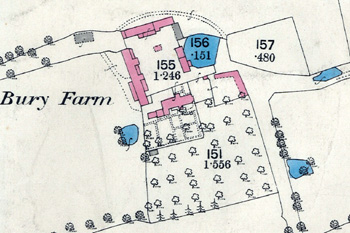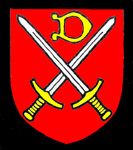Bury Farm Caddington

Bury Farm on a map of 1880
The Victoria County History states: “About one mile west from the church there is now a farm called the Bury Farm. The farmhouse of the seventeenth century is probably on the site of the old manor house”. The manor in question was Caddington Manor.
The first volume published by Bedfordshire Historical Record Society, in 1913 has an article by C. Gore Chambers on the lease of the manor in 1299. Bedfordshire and Luton Archives and Records Service Office staff [CRT130Caddington8] added a description of the manor house, outbuildings and land in 1299 to descriptions in later lease of 1457 [CRT130Caddington4/2] and in the sale in 1649. The three descriptions are as follows:
- 1299: a hall, half roofed with shingles, half with tiles, with spense and buttery at the east end, and a small upper room above them, roofed with tiles, without a garderobe [i.e. a privy]; a good large new upper room at the west end, roofed with tiles and garderobe adjoining; a chapel built of stone and roofed with tiles with a cellar beneath; and a roofed enclosure before the cellar door; a tile roofed passage between the chapel and the hall; two great barns, one wholly of oak and one new barn of beach; under one roof a kitchen, bakehouse and a brewhouse, roofed with tiles with lead and furnace; a serviceable fowl house; a well-roofed granary; a new stable; a gateway with rooms on either side and a room over; a smithy, tiled; a thatched carthouse; a dairy; a drying kiln; a serviceable thatched sheepcote at Gerdlers with a building for the use of the shepherd; a serviceable sheepcote at the gate of the manor; a well with a wheel and wheelhouse; a windmill; 60 acres sown with wheat; 80 acres sewn with oats and 105 acres left fallow;
- 1457: a hall, at one end a high chamber with a fireplace and a low chamber; another high chamber and a “draught chamber” with a privy adjoining; at the other end of the hall another high chamber and under it a pantry and buttery; a chapel and passage way to the same; a long house with a larder , bakery and oven; two barns for grain; an old barn for hay, stable, byre and pigsty; a gateway with a room over and various high and low chambers and a privy; a granary; 50 acres sown with corn; 80 acres sown with oats; 105 acres left fallow;
- 1649: a capital messuage and manor house consisting of a hall, parlour, low lodging room adjoining the parlour; four lodging chambers; a servants’ chamber; a bakehouse; a brewhouse; a slaughterhouse; a milk house; a cellar; a buttery; two granaries, one above the other; three barns; one dovehouse; two stables; three cow houses; a cart house; a well house; 313 acres of land.
It seems clear that the buildings of 1299 and 1457 were substantially the same and that they might have survived in some way until 1649, certainly mention of a hall and a low lodging suggests that it is the medieval building.
The Bedfordshire Historic Environment Record [HER] contains information on the county’s historic buildings and landscapes and summaries of each entry can now be found online as part of the Heritage Gateway website. The entry for Bury Farm [HER 13586] reads as follows: “Bury Farm in Caddington is a 17th century farm which appears to be located on the site of a 13th century manor known as Caddington Bury. Neither of these buildings remain, and they are known to have disappeared by the 1920's [but see the 1925 rating valuation survey below]”.
“Most of the documentary evidence for the site concerns the 13th century manor. The manor was located west of Caddington Church. The documents show that in 1299 and 1457 there is a Hall which included a pantry and buttery, with rooms over them but no privy. At the ends of the hall were larger chambers which did contain privies. At this time there was also a chapel with a passageway to it. There were also 3 barns and a granary, and a gateway with rooms over it and on each side. A well was also present on the site”.
“By 1649 there were still 3 barns but now 2 granaries. There is also evidence that a windmill may have been associated with the Manor but that it disappeared between 1299 and 1457”.

Saint Paul's Dean and Chapter
Bury Farm, as part of Caddington Manor, was owned by the Lords of the Manor, the Dean and Chapter of Saint Paul’s in London. They were recorded as holding the manor at the time of the Domesday Book of 1086 and continued to hold it until 1872 when the Church Commissioners took over responsibility. They soon began negotiations to sell and part of Bury Farm was acquired Arthur Macnamara who already had substantial estates in the area [X606/10].
Bedfordshire and Luton Archives and Records Service has a number of pieces of evidence for Bury Farm through the 20th century. At the turn of that century the farm was owned by John Macnamara and occupied by the appropriately named John Hedges. In 1901 an agreement [BML10/11/9] was made for Arthur walker to “manage and attend to the business of the farm” if Hedges’ Health failed. Sadly this seems to have been the case because at Michaelmas that year George Peck became tenant [Z740/23/5]. He made a sale of livestock and implements in 1904 [Z740/23/7].
At some point shortly hereafter Macnamara sold his holdings in Caddington because by 1919 the trustees of the late John Sambrook Crawley were in possession and had the farm valued [BML10/11/28]. Christopher Brigginshaw was then the tenant.
The Rating and Valuation Act 1925 specified that every building and piece of land in the country was to be assessed to determine its rateable value. The valuer visiting Bury Farm [DV1/H24/30] found it owned by Mrs. Ross Skinner, who had been a Crawley before marriage. She also owned both farms at Chaul End as well as Gatehouse, Inions, Prebendal, Turnpike and Zouches Farms – a total of nearly 1,800 acres.
Bury Farm comprised 326 acres, six fewer than in 1914. It was leased to Sidney G. Cripps for £250 per annum, a rent set in 1919. The rent from 1904 had been £200. The valuer commented: “House now divided into two, half used as cottage. One room in other half furnished as sitting room, downstairs rooms used as stores. Upstairs derelict. Decent barns, accommodation for stock bad. No drainage in yards. “Damn bad farm”. Three horse land. Not enough water in ponds in summer”. Another valuer agreed that the farm was not a good one, writing: “Poor farm. Was Peck’s, gone down since … Homestead rambling”.
The old farmhouse comprised two small reception rooms, a kitchen and scullery with three bedrooms above in the occupied half. The unoccupied half comprised a sitting room for the farmer, two store rooms and three unused bedrooms. The valuer noted: “Water from well 300 feet deep”.
The homestead comprised the following:
- By the house – all brick and slate: a well house; a lumber shed; a pig food room; a trap house and a blacksmith’s shop (“bad”);
- Round the yard: a weather-boarded and corrugated iron lean-to cow house; a barn; three lean-to pigsties and a weather-boarded and corrugated iron lean-to shed;
- On the north side: a corrugated iron barn with a lean-to open-fronted shed;
- East range: a six bay open-fronted cattle shed; a weather-boarded and slated stable for ten horses with a loft over (“very bad”) and a weather-boarded and corrugated iron lean-to shed;
- In the sheep yard: a weather-boarded and slated eleven bay open-fronted shed;
- In the rick yard: a weather-boarded and corrugated iron four bay open-fronted cart shed and a weather-boarded and tiled lean-to implement shed.
Being close to Luton, Caddington received a fair share of stray bombs during World War Two. It was surprisingly late in the war that any landed near Bury Farm. On 4th February 1944 one report detailed that over a hundred one kilogramme incendiaries and an oil bomb were dropped near Bury Farm as well as in Luton Road and close to 9 Folly Lane [WW2/AR/CO/2/3]. Another report gives a figure of sixty incendiaries in a field two hundred yards north-east of the farm house and a further one hundred and fifty “in fields and woodland over a half mile radius” [WW2/AR/CO/3/2]. By this stage of the war the Luftwaffe was increasingly ineffective and Hitler’s thought were beginning to turn to new terror weapons, the V1 rockets, the first of which would be launched against Britain in June that year.